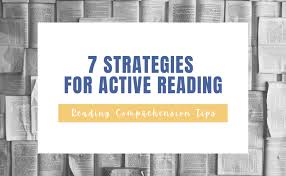As high school English teachers, we can sometimes find ourselves at a loss when students come through our doors reading significantly below grade level.
I remember asking my mentor teacher, “How can I help a high school student reading at an elementary level, when I haven’t been trained in teaching reading?”
But working at a school with a large population of struggling readers meant I had to learn… and I had to learn fast.
Here are 7 Active Reading Strategies that will help your students read better …and maybe even come away when a genuine love for reading!
Reading Strategy #1: Review
This strategy is one of the most overlooked, but it’s key. Students have a lot going on in their lives and haven’t necessarily been thinking about our whole class novel or their independent reading choice all day.
Help your students review what they read last time, so that they enter the text fully prepared and aware of the nuances that can slip away in the days between reading.
Reading Strategy #2: Predict
Another way to move students from passive reading to active reading is by asking them to make predictions as they go. It sounds simple, but predictions require students to sort and make sense of many aspects of a text, from character development to background knowledge and beyond.
Students continue reading actively after predicting because they’re looking to confirm their prediction or to find out why the character did something different or why things didn’t turn out the way they predicted.
Reading Strategy #3: Visualize
Authors often use long-winded descriptions purposefully, usually as a way to speak about a larger concept that is more symbolic in nature: We so clearly see the symbolism behind Steinbeck’s description of the turtle making its way across the road or Fitzgerad’s description of the Valley of Ashes or Lee’s description of Boo Radley’s House.
We know this as teachers, but less experienced readers often view these descriptions as “boring” or superfluous because there isn’t any “action.” Teaching students to slow down and look more closely at the details can be a great way to help them understand the deeper meaning behind these kinds of descriptions.
Reading Strategy #4: Question
As students read, encourage them to ask questions – not the kind of questions they find on comprehension worksheets or reading quizzes that can simply be found in the text, but the kind of questions that leave you wondering without any clear answer.
With my students I call these “wonder questions.” We ask what characters were thinking or why characters took certain actions. We ask why authors are using a specific word or describing some specific detail in a certain way.
The key with any wonder question is for students to make an attempt to answer the question. They have to put themselves into the shoes of the reader or the author and they have to keep reading to see if they’ll ever find the answer.
Reading Strategy #5: Connect
Ask students to draw connections between the text they’re reading and their own lives and backgrounds, other texts they’ve read, or other experiences they’ve had.
These connections help students identify with characters and stories on a deeper level and ultimately lead to greater engagement.
Reading Strategy #6: Infer
Inference can be a tough skill to teach, but it is SO important, especially with the more challenging texts students will read as they move through the grade levels.
I often introduce this concept by asking students if they’ve ever had a friend say they’re “fine” when they’re definitely not fine. I even act it out, spitting the word, “fine,” and standing with my arms crossed and my weight shifted to one leg.
We talk about how we know that friend is definitely not fine and how that moment is so different from the friend saying, “thanks for asking. I’m feeling pretty sad and upset right now because…”
Throughout whole class readings, I pause and ask them to infer and I do my best to always point out that we’re inferring, so that they can see how useful the skill is and so they can see the skill in action.
Reading Strategy #7: Condense
Finally, teaching students to condense what they’ve read into a short “gist” is a really powerful way to help students engage with the content. It requires them to boil down many pages with many characters, interactions, and details into just a single, most important main idea.
Condensing is different from paraphrasing, summarizing, and retelling because it asks students to take whatever they read and to condense that down into a single sentence. We often follow a who, what, where, why, how format when we practice this skill (…and then we play with re-ordering the sentences as a fun way to incorporate grammar in context!)
Want to implement these reading strategies but not sure how?
My favorite way to introduce these strategies is with children’s literature. I know, I know – we’re teaching high school, right?? But yes – even high school students LOVE the nostalgia of circling up on the floor while I read to them from a kids picture book. After I finish reading, we go back and I guide them through using active reading strategies. Children’s lit tends to be incredibly witty and layered with fun details that are easy to miss on the first go around, which makes using active reading strategies a perfect way to help students see the power of using them!
I also love to incorporate the active reading strategies through independent reading. Students read a book of choice for the first 5-10 minutes of class and end each reading session by choosing one strategy to use as they complete their reading log.
Looking for a fun way to teach active reading strategies in the fall?
Try reading a spooky short story like Edgar Allan Poe’s “The Masque of the Red Death” or his famous poem “Annabel Lee” using the active reading strategies.
Or consider using active reading strategies to introduce your students to the power of a Growth Mindset as you start your school year!
Want to read more about reading strategies to try in the secondary classroom?
Check out our blog post: 5 Teacher Tested Reading Strategies You Could Implement Tomorrow
Which of these strategies do you already teach? I’d love to hear how YOU teach them in your classes!

